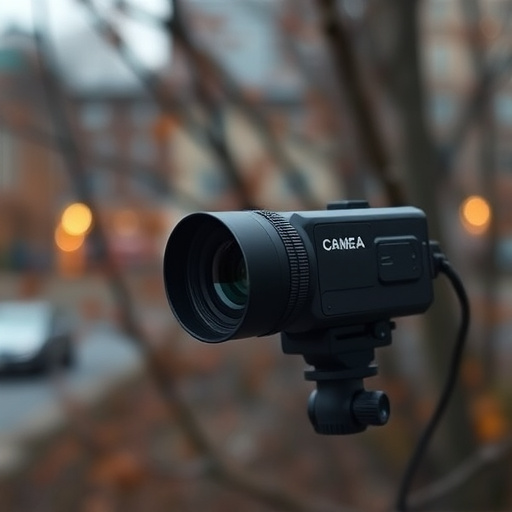Renters using Airbnb should be vigilant against hidden security cameras by meticulously inspecting for unusual devices disguised as everyday items, such as mirrors and power outlets. Using flashlights and paying attention to wiring can aid in detection. Advanced tools like heat-sensing cameras and AI apps offer additional help. Balancing privacy rights with security needs is crucial; local laws should guide this process, fostering open dialogue between tenants and property managers for a trustworthy environment.
Uncover the hidden eyes: Navigating the world of security camera concealment is a growing concern, especially in shared spaces like Airbnb properties. This guide delves into the art of detecting spy cameras, providing practical techniques and advanced tools for the discerning traveler or host. From understanding the common hideouts to legal implications, we explore effective methods on how to spot spy cameras in Airbnb, ensuring peace of mind in an increasingly digital age.
- Understanding Spy Cameras and Their Common Hideouts in Airbnb Properties
- Visual Inspection Techniques to Spot Hidden Cameras
- Advanced Tools and Technologies for Camera Detection
- Legal Considerations and Ethical Implications of Detecting Spy Cameras
Understanding Spy Cameras and Their Common Hideouts in Airbnb Properties
Many people are unaware that their rental homes could be equipped with hidden security cameras, known as spy cameras. These devices are often installed in Airbnb properties to capture intimate moments for malicious purposes. Understanding where these cameras might be concealed is the first step towards ensuring your privacy while renting.
Common hideouts include mirrors, light switches, smoke detectors, and even fake fire alarms. Some advanced models can be disguised as everyday objects like plant pots or power outlets. When checking into a new Airbnb, take a moment to scrutinize these areas. Look for any unusual attachments, cracks, or markings that might suggest the presence of hidden equipment. It’s important to know your rights and legal protections regarding privacy in rental spaces.
Visual Inspection Techniques to Spot Hidden Cameras
When it comes to identifying hidden security cameras, especially in shared spaces like Airbnbs, visual inspection techniques are key. Start by carefully examining every corner and crevice with your naked eye. Look for any unusual objects or devices that don’t seem to belong, such as small, compact cameras disguised as everyday items like smoke detectors, light switches, or even wall art. Pay close attention to mirrors, which can reflect hidden cameras from adjacent rooms.
Use a flashlight to shine into tight spaces and behind surfaces, as cameras often emit faint lights or have irregular reflections. Additionally, look for any signs of tampering with the wiring or unusual mounting of fixtures. While it’s not always possible to spot every single spy camera, these visual inspection methods significantly increase your chances of identifying them, ensuring a safer and more secure environment during your stay at an Airbnb.
Advanced Tools and Technologies for Camera Detection
In today’s digital era, advanced tools and technologies have emerged to aid in detecting security camera concealed locations, especially in shared spaces like Airbnbs. One popular method involves utilizing specialized heat-sensing cameras that can detect infrared signals emitted by hidden cameras, making it easier to spot devices not visible to the naked eye. Additionally, there are apps designed with AI capabilities that analyze visual feeds and identify patterns indicative of spy cameras. These innovative tools offer a proactive approach for tenants and property managers to ensure privacy.
Another effective strategy is to employ physical obstructions and reflective surfaces to disrupt camera lines of sight. For instance, strategically placing mirrors or reflective decor can reflect light away from the camera lens, making it less effective. Furthermore, using opaque covers or adhesive films over cameras can physically block the lens, rendering them useless for surveillance. By combining these technological advancements with practical physical obstructions, individuals can enhance their privacy when staying in Airbnbs or managing rental properties.
Legal Considerations and Ethical Implications of Detecting Spy Cameras
When considering how to spot spy cameras, especially in shared spaces like Airbnb properties, it’s crucial to navigate a delicate balance between practical security measures and legal boundaries. In many regions, installing hidden cameras without explicit consent is illegal, potentially infringing on privacy rights. This becomes particularly relevant when renting out homes or accommodations, as guests expect a certain level of privacy. Therefore, any attempt to detect spy cameras must adhere to local laws and respect tenant rights.
Ethical implications also come into play, especially with the proliferation of advanced technology. While securing your property is reasonable, utilizing covert surveillance can create an atmosphere of distrust. It’s essential to foster open communication and transparency, ensuring guests feel comfortable discussing any security concerns. Additionally, professionals offering detection services should operate within ethical guidelines, promoting trust and maintaining the integrity of privacy rights in the digital age.
Understanding how to spot spy cameras, especially in shared accommodation like Airbnb properties, is a crucial step towards protecting personal privacy. By familiarizing yourself with visual inspection techniques and leveraging advanced detection tools, you can navigate your surroundings with enhanced awareness. Remember that while legal considerations vary by region, being proactive about identifying hidden cameras promotes an ethical and safe environment for all users. With this guide’s practical insights, you’re better equipped to recognize potential surveillance devices and take appropriate action.
